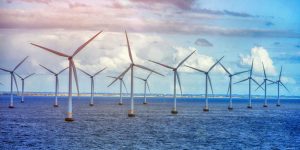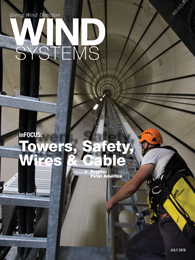The offshore sector of the wind industry has made headlines in recent months. It has progressed rapidly, both in technical innovation and in the competitiveness of offshore energy in the electricity market. Many of the companies active in the offshore wind market are presenting their portfolios at WindEnergy Hamburg, the world’s leading expo for onshore and offshore wind energy, September 25-28. The expo will be held in parallel with the global conference of WindEurope at the Hamburg Messe site — together they comprise the Global Wind Summit, the biggest and most important meeting of the wind industry worldwide. WindEnergy Hamburg is expecting about 1,400 exhibitors from all parts of the world, with about 40 percent of them showcasing products or services for offshore wind farms. The range covers the whole of the value chain, from turbines, towers, and foundations to gearboxes, generators, bearings, shafts, and lubes, as well as O&M solutions and installation vessels.
Global world market growth
Besides main offshore wind market Europe, other geographical regions of the world might start experiencing quick growth too in the next years, says GWEC in its 2017 Global Wind Report. The organization points at emerging markets with huge interest in the technology and substantial growth potential including Taiwan, South Korea, the U.S. (East Coast), Japan, India, Brazil, and Australia. China is already the largest offshore market outside Europe, with, according Wikipedia ‘Liste der Offshore-Windparks’ statistics, close to 2 GW of operation at the end of 2017. Among Chinese offshore wind exhibitors in Hamburg are turbine OEM’s Envison Energy and Ming Yang.
Offshore, according to GWEC, represented about 8 percent of the global market last year, and it represents 3.5 percent of the cumulative installed capacity, but it’s growing fast. Global offshore installations in 2017 were 4,334 MW, of which about 27 percent was installed in markets outside Europe. Overall, there are now 18,814 MW of installed offshore capacity around the world.
According to WindEurope’s report “Offshore Wind in Europe; Key trends and statistics 2017,” Europe’s net installed capacity, spread over 560 new turbines across 17 windfarms, increased last year by 3,148 MW. The average offshore turbine capacity more than doubled to 5.9 MW over the past decade, and 23 percent higher set against 2016. Project size for offshore windfarms under construction during 2017 grew to 493 MW from a 79.6 MW average in 2007. The current windfarm size record holder is the 1.2 GW Hornsea One project (U.K.) with construction starting this year. A 2017 floating wind milestone was the commissioning of the world’s first windfarm, Scotland’s 30 MW Hywind II consisting of five 6 MW Siemens Gamesa direct drive turbines.
Internationally, new innovative technology and fresh solutions for “traditional” fixed-bottom and floating wind generated huge interest. A number of Belgian exhibitors, all active in offshore wind, jointly represented themselves in Hamburg as the BOC VZW Belgian Offshore Cluster in a national pavilion. BOC is an association of offshore wind industry co-suppliers with about 60 members.
“At the Belgian pavilion at WindEnergy Hamburg, our partners will highlight their specific know-how and experiences to international wind-industry visitors,” said BOC Chairman Christophe Dehaene.
A main overall theme for all international contenders is how to successfully enter new and emerging markets. The Global Wind Summit in Hamburg offers an excellent platform opportunity. A second main theme is achieving optimized cost-effectiveness through the deployment of next-generation large-scale turbines.
Siemens Gamesa and MHI Vestas dominate Europe’s largest offshore wind market with direct drive and medium-speed geared turbine solutions respectively, in ratings up to 9.5 MW. They and other exhibitors such as GE Renewable Energy and Senvion all explore next-generation 10 to 15-plus MW future platforms. German engineering consultancy aerodyn-engineering develops a fully integrated 15 MW floating system incorporating twin 7.5 MW two-bladed counter-rotating downwind turbines with 150-meter rotor diameters.

(Courtesy: WindEnergy Hamburg)
107-meter rotor blades
GE’s 12 MW Haliade X direct drive turbine in development features a record 220-meter rotor composed of 107-meter blades developed by LM Wind Power of Denmark. The turbine, with first deliveries planned in 2021, features only 316 W/m2 specific power rating, a configuration showing future direction for other large-scale turbine developments. Such supersize rotor offers higher yields, especially during periods with little wind. When this coincides with high wind power penetration levels under liberalized market conditions in specific offshore wind markets, it could contribute to better electricity prices. A related positive impact is enhanced grid stability. All these aspects form an integral part of many different smart energy solutions, including intermediate storage technologies being developed by Hamburg WindEnergy exhibitors from across the world. They also will explain to international visitors the latest technology advancements regarding industrialization, with increased use of “big data.” This offers offshore wind farms combined benefits like higher operating reliability through better longer-term failure prediction and smarter cost-reducing O&M solutions. This long-time turbine tracking could result in more advanced windfarm upkeep strategies primarily aimed at further driving down offshore LCOE.
Substructures
Monopiles were the most popular structure solution of all new installed foundations in 2017 with 87 percent, with jackets taking second position with 9.4 percent, according to WindEurope. WindEnergy Hamburg exhibitors EEW Group and SIF Netherlands led Europe’s total offshore substructure market with shares of 53 percent and 24.1 percent respectively.
“EEW SPC manufactures monopiles currently up to 10-meter diameter. Our daughter company EEW OSB produces TPs in the U.K., and EEW Group also manufactures pre-fabricated components for jackets. This range of products made by EEW offers flexibility to our existing clients and will enable a necessary leap forward in emerging main offshore markets like the U.S. and Asia,” said Michael Hof, COO/managing director of EEW SPC.
The largest monopiles available weigh about 1,500 around metric tons, which puts additional pressure to continuously upgrade vessels, foundation handling, and hoisting gear capacities and performance. Multiple wind-farm installation specialists will show their combined in-house capabilities to Hamburg WindEnergy visitors.Exhibitor Van Oord Offshore recently took delivery of a new 1,600-metric-ton main crane re-fitted at its self-propelled Aeolus jack-up, initially commissioned in 2014 with a 900-metric-ton crane. Damen Shipyards will inform visitors about its novel ‘walk-to-work’ Service Operations Vessel (SOV) for offshore windfarm upkeep.
Floating solutions
Several international floater developers will highlight their dedicated floating concepts to WindEnergy Hamburg visitors, like aerodyn-engineering and GustoMSC (semi-submersible) and GICON (tension-leg, TLP), while spar-type solutions are characterized by their operational stability.
“WindEnergy Hamburg 2018 is, for us, an important international platform,” said GICON Founder Prof. Jochen Grossmann. “Last year, GICON teamed up with U.S.-based Glosten, developer of the Pelastar TLP. We in-house developed GICON-SOF TLP technology during the past decade. Individual strengths of both commercially ready products will be combined into a new hybrid solution for the global floating wind market, and we will show international visitors all features and benefits.”
Floating offshore wind in general enjoys growing wind-industry interest, reflected by the increasing number of projects and the larger turbines sizes selected for these platforms.
Source: WindEnergy Hamburg
For more information, go to www.windenergyhamburg.com/en/




























